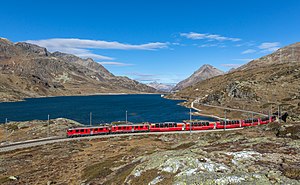This article includes a list of references, related reading, or external links, but its sources remain unclear because it lacks inline citations. (January 2021) |
 Bernina Express on the Bernina line, passing Lago Bianco | |
| Overview | |
|---|---|
| Service type | Inter-city |
| Status | Operating |
| Locale | Graubünden, Switzerland Sondrio, Italy |
| Current operator(s) | Rhaetian Railway |
| Former operator(s) | Bernina-Bahngesellschaft |
| Route | |
| Termini | Chur / Davos / St Moritz Tirano |
| Distance travelled | Varies |
| Average journey time | 4 hours |
| Service frequency | Daily |
| On-board services | |
| Class(es) | 1st and 2nd |
| Disabled access | Yes |
| Catering facilities | Minibar |
| Observation facilities | Panorama cars |
| Technical | |
| Rolling stock | Panorama cars |
| Track gauge | 1,000 mm (3 ft 3+3⁄8 in) metre gauge |
| Electrification | 11 kV AC 16⅔ Hz (core network) 1,000 V DC (Bernina line) |
The Bernina Express is a train connecting Chur (or Davos) in Switzerland to Poschiavo in Switzerland and Tirano in Italy by crossing the Swiss Engadin Alps. For most of its journey, the train also runs along the World Heritage Site known as the Rhaetian Railway in the Albula / Bernina Landscapes.
The train is operated by the Rhaetian Railway company for the purpose of sightseeing. It takes the form of an enhanced regional service between Tirano and Chur or Davos: panoramic coaches with enlarged windows and multi-lingual (English, Italian and German) audio guide on board. It is not an "express" in the sense of being a high-speed train; passengers must make a seat reservation either directly when they purchase Bernina Express tickets, or pay a small supplement on top of their regional train tickets. The Bernina Express is popular with tourists and connects in Tirano with the Post Bus service via Lake Como in Italy to Lugano in Switzerland.
The Albula line and the Bernina line on the Bernina Express's route were jointly declared a World Heritage Site in 2008. The trip on the Bernina Express through this World Heritage Site is a four-hour railway journey across 196 bridges, through 55 tunnels and across the Bernina Pass at 2,253 metres (7,392 ft) above sea level. The entire line is 1,000 mm (3 ft 3+3⁄8 in) (metre gauge) and electrified.
The Albula line was constructed between 1898 and 1904; it has been operated by the Rhaetian Railway since its inauguration. The Bernina line was built between 1908 and 1910 and operated independently until the 1940s, when it was acquired by the Rhaetian Railway. The Bernina Express uses gradients of 7% to negotiate the difference in height of about 1,800 m (5,900 ft) from the summit at Ospizio Bernina to Tirano.